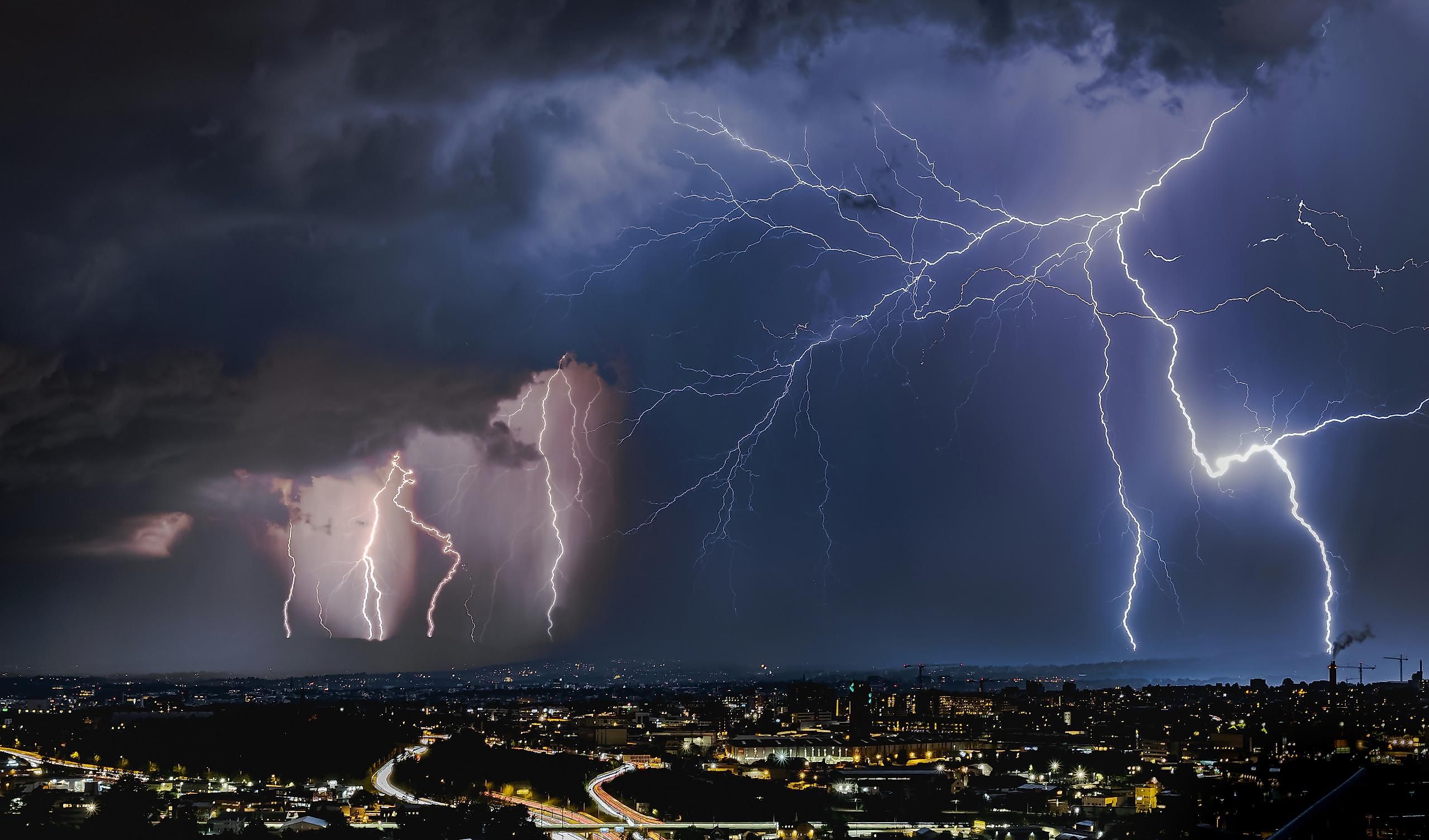
Thunderstorms
Also referred to as an electrical or lightning storm, thunderstorms are weather disturbances characterized by dense clouds, heavy rainfall, strong winds, and the presence of lightning and thunder. Thunderstorms are formed whenever there is a rapid rise of warm and moist air. Severe thunderstorms include some of the most devastating weather phenomena, like tornadoes, large hail, flash floods, and heavy winds. Thunderstorms occur during the spring and summer seasons in temperate regions, whereas in tropical areas, they are expected during the wet season. Experts have estimated that throughout the world, over 2000 thunderstorms are in progress at any given moment, and each storm poses a severe threat to human and animal life.
Where Do Thunderstorms Occur?
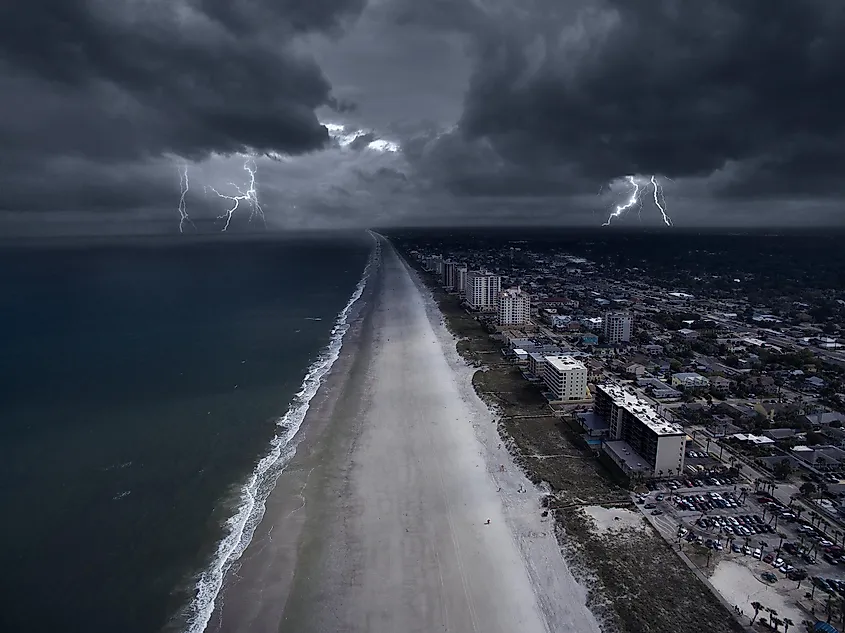
Thunderstorms are known to develop in almost any geographic location though they are pretty rare in the polar regions and uncommon at latitudes above 50°N and 50°S. Therefore, thunderstorms are common in mid-latitudes, mainly in the tropical and temperate areas of the world. With more than 80 thunderstorm days per year, the Florida Peninsula is prone to maximum thunderstorm activity in the United States, followed by the Gulf Coast and the New Mexico mountains. On average, Asia and Central Europe receive 20 to 60 thunderstorms per year.
Types Of Thunderstorms
Depending on the instability and relative wind conditions at the different atmospheric layers, thunderstorms are of four major types: single-cell thunderstorms, multi-cell thunderstorms, squall lines, and supercells.
Single-cell Thunderstorm
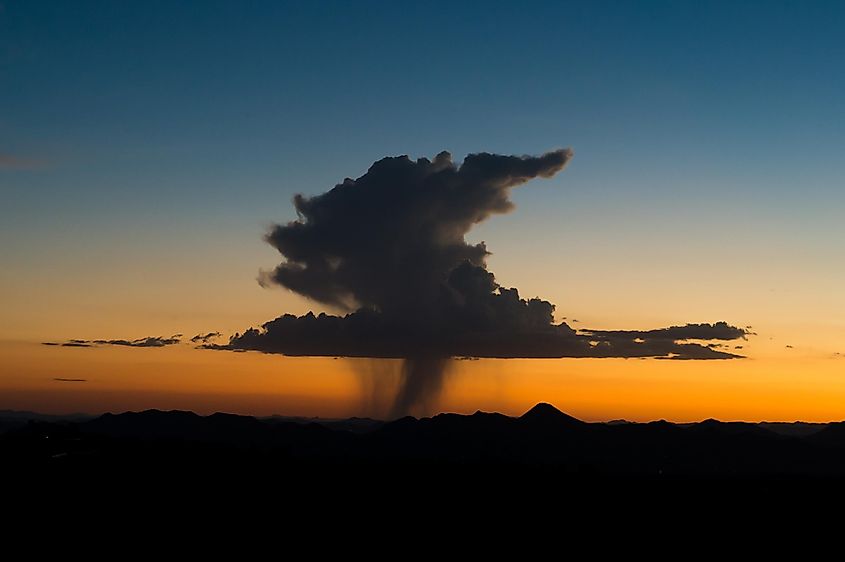
Also referred to as an air-mass thunderstorm, single-cell thunderstorms refer to those thunderstorms that are created by a single convection cell. Single-cell thunderstorms are formed in environments having small amounts of “convective available potential energy,” as well as low levels of helicity and wind shear. These thunderstorms, however, do not last more than an hour but have threats of lightning and heavy rainfall. Single-cell thunderstorms are common during summer afternoons in temperate zones.
Multi-cell Thunderstorm
These thunderstorms contain more than one convection cell, each at a different stage in a thunderstorm’s life cycle. Multi-cell thunderstorms are preceded by forceful wind gusts and appear like many anvils clustered together. While each individual cell lasts for about 20 to 60 minutes, the entire multicellular cluster lasts for several hours. Even though multi-cell thunderstorms are stronger than single-cell thunderstorms, they are comparatively weaker than supercell storms. Weak tornadoes, flash floods, and moderate-sized hail are some hazards associated with multi-cell thunderstorms.
Squall Line
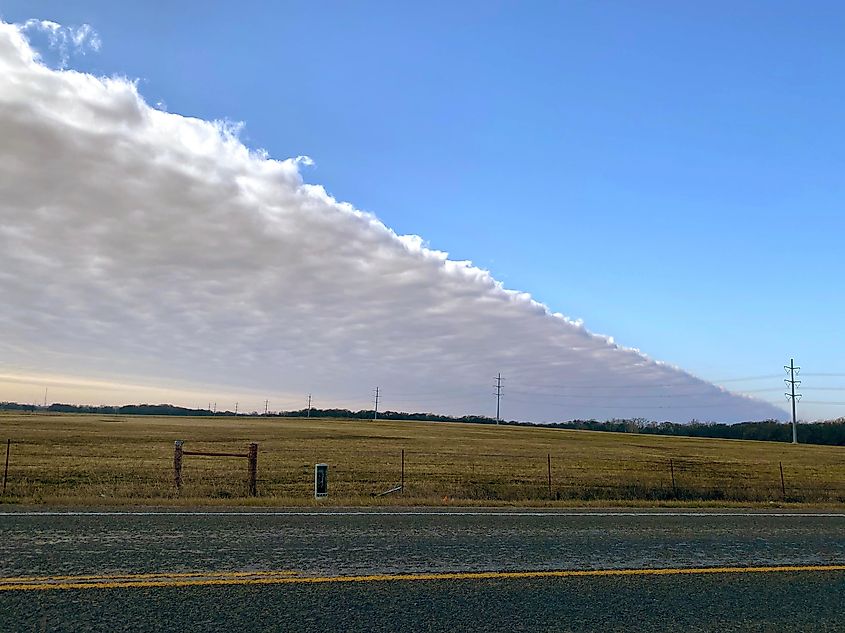
Often called a “quasi-linear convective system,” a squall line refers to a series of severe thunderstorms that form along or at the fore of a cold front. The squall line is characterized by strong winds, heavy precipitation, frequent lightning, hail, tornadoes, and waterspouts. Severe weather is experienced in areas where the squall line has the shape of a bow echo, while tornadoes are experienced in places where mesoscale low-pressure areas are present.
Supercells
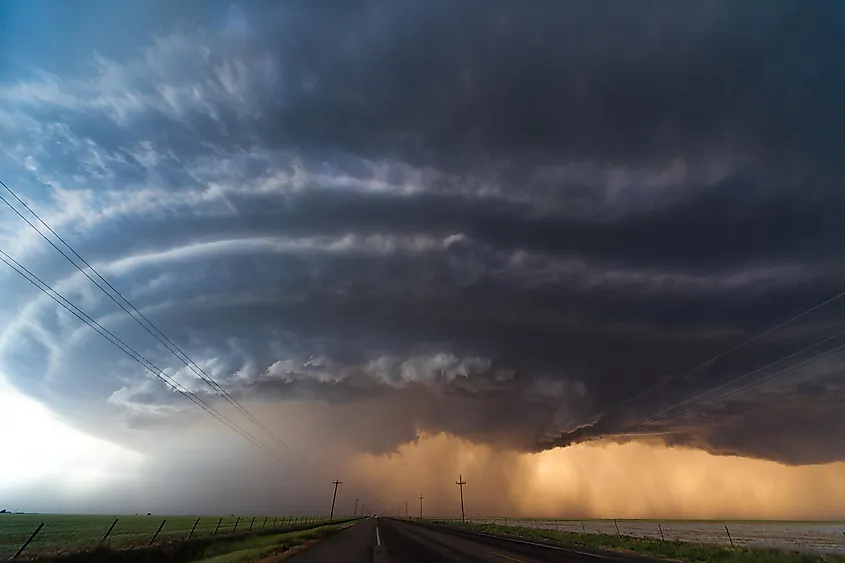
A Supercell thunderstorm is the strongest type of thunderstorm characterized by a deep, constantly rotating updraft. This type of thunderstorm lasts for 2 to 4 hours and is considered the least common but the most severe of all thunderstorms. Supercell thunderstorms produce extremely large hailstones, flash floods, destructive tornadoes, and strong winds of over 81 mph. Though these thunderstorms can occur anywhere in the world with suitable pre-existing weather conditions, they are most common in the Tornado Alley in the Great Plains of the United States.
Life Cycle Of A Thunderstorm
On average, a thunderstorm has a diameter of about 15 miles and requires three conditions for its formation. These are the presence of moisture, an unstable airmass, and a lifting force. Regardless of the type, all thunderstorms go through three different stages in their life cycle: the developing/cumulus stage, the mature stage, and the dissipation stage. Depending upon the atmospheric conditions, it takes an average of 30 minutes for each of these three stages.
Developing/Cumulus Stage
The cumulus or developing stage is the first stage of a thunderstorm. The heating of the Earth’s surface due to solar illumination results in lifting masses of moisture upwards into the atmosphere. Due to lower temperatures at high altitudes, the moisture mass carried upwards cools into liquid drops of water and appears as cumulus clouds. The subsequent condensation of water vapor into liquid releases latent heat, which in turn warms the air, making it comparatively less dense than the surrounding dry air. The cumulus stage results in the formation of a low-pressure zone both within and underneath the growing thunderstorm.
Mature Stage
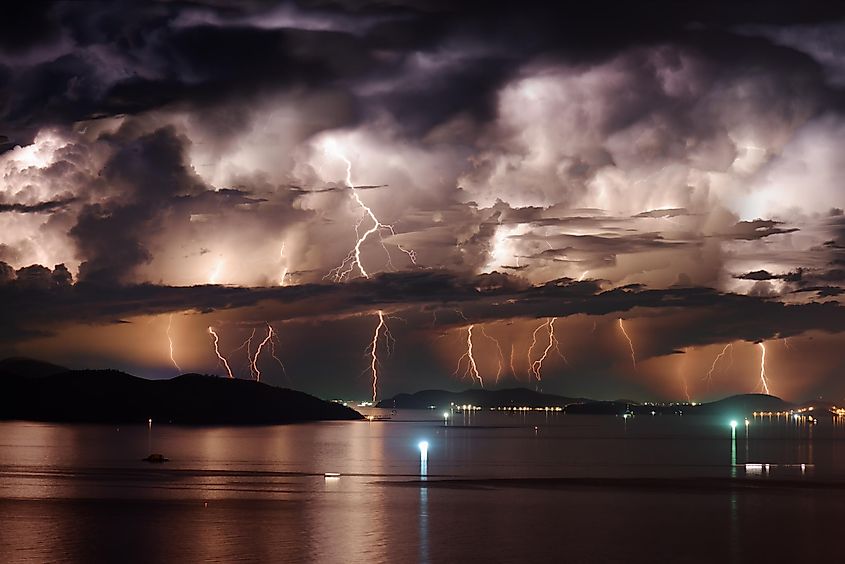
In this stage, the warmer air continues to rise until it reaches an area where it can rise no further. The air is therefore forced to spread out, giving the storm a distinctive anvil shape. This resulting cloud is then referred to as ‘cumulonimbus incus.’ As the cloud grows in size, the water droplets in the cloud become large and heavy and freeze to form ice particles. As these ice particles fall, they melt to form rain. If a strong updraft is present, then the droplets are held aloft quite longer. However, these droplets then do not dissolve entirely and instead fall as hail. As the raindrops start falling through the clouds, cool dry air enters the cloud, and the phenomenon of downdraft begins. This simultaneous presence of both updraft and downdraft results in the mature stage of a thunderstorm to produce cumulonimbus clouds.
Inside the clouds, the collision between the water droplets and ice crystals knocks the electrons off the water droplets and lighter ice crystals and gradually shifts them to larger ice particles. As the comparatively heavier negatively-charged particles sink, the positively charged particles rise. This leads to the accumulation of opposite charges at the top and bottom of the clouds and produces a voltage difference, in turn generating an ‘intra-cloud lightning.’ The electrons on the ground are repelled by the negatively charged cloud base, resulting in the creation of a positive charge. This potential difference generates a flash of ‘cloud-to-ground’ lightning. This flash of light is accompanied by a distinctive rumble of thunder caused by the rapid heating and expansion of the surrounding air.
During the mature stage, considerable internal turbulence occurs in the thunderstorm, manifesting as gusty winds, severe lightning, and tornadoes. It must be noted that if there is little wind shear, then the resulting thunderstorm will rapidly dissipate. However, if there is a change in wind speed or direction, then this will lead to the separation of the downdraft from the updraft, and the thunderstorm can transform into a supercell, sustaining the mature stage for several hours.
Dissipating Stage
Downdraft mainly dominates the dissipation stage. If suitable atmospheric conditions do not support the development of supercells, then the dissipating stage occurs about 20 to 30 minutes into a thunderstorm’s life. The downdraft then pushes out of the thunderstorm and spreads out after hitting the ground. The cool air, which is carried to the ground by the downdraft, cuts the inflow of the thunderstorm. This leads to the updraft's disappearance and the thunderstorm's eventual dissipation.
Hazards Associated With Thunderstorms
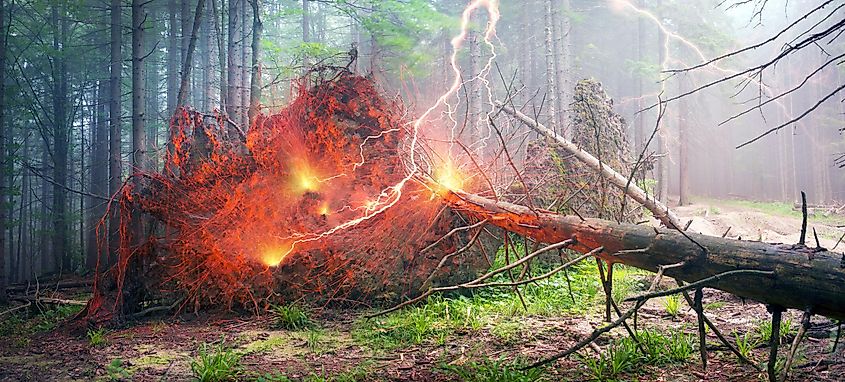
Despite the early warnings by the meteorologists, several people are killed every year by severe thunderstorms. In the United States, a thunderstorm is categorized as ‘severe’ if it has wind speeds of more than 58 mph, hail having more than a 1-inch diameter, and the presence of funnel clouds. Some of the hazards associated with severe thunderstorms include ‘cloud-to-ground’ lightning that can generate wildfires and cause several fatalities; the production of large hailstorms causing severe damage to crops, glass-roofed structures, aircraft, automobiles, and many more; generation of tornadoes and waterspouts; flash floods; downburst; and thunderstorm asthma.

In recent times, the excess release of greenhouse gas emissions by anthropogenic human activities has made the lower atmosphere of the Earth relatively warmer and moister. This warming of the Earth is resulting in more frequent and intense weather events. Moreover, with a rise in warming, conditions favoring strong thunderstorms that spawn destructive tornadoes are expected to increase. Therefore, it is of utmost necessity to have a proper understanding of thunderstorms, their formation, and associated hazards. One must also take ample precautions whenever warnings about such extreme weather events are issued to minimize the loss of precious lives and property.











